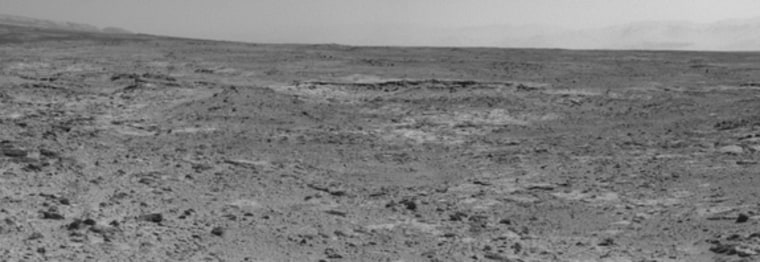NASA's Mars rover Curiosity is sizing up its next scientific target — the first rocks the car-size robot will reach out and touch in more than a month.
On Monday, the 1-ton Curiosity rover took some scouting photos of a rocky outcrop called "Cooperstown" from about 262 feet (80 meters) away. Mission researchers plan to investigate Cooperstown with Curiosity's arm-mounted instruments soon, putting this science gear to such use for the first time since Sept. 22.
Curiosity has been making tracks over the last month or so, chewing up ground as it heads from a spot near its landing site called Yellowknife Bay to the rover's main science destination, a 3.4-mile-high (5.5 kilometers) massif called Mount Sharp. [Amazing Mars Rover Curiosity's Martian Views (Latest Photos)]
"What interests us about this site is an intriguing outcrop of layered material visible in the orbital images," Kevin Lewis of Princeton University, a mission participating scientist who has helped lead planning for the Cooperstown activities, said in a statement. "We want to see how the local layered outcrop at Cooperstown may help us relate the geology of Yellowknife Bay to the geology of Mount Sharp."
Curiosity touched down inside Mars' huge Gale Crater in August 2012, kicking off a planned two-year surface mission to determine if the Red Planet could ever have supported microbial life. The rover team has already checked off this milestone, determining in March that Yellowknife Bay was indeed habitable billions of years ago.
But Curiosity's work is far from done. The robot's handlers are eager to reach Mount Sharp, whose many layers record a history of Mars' changing environmental conditions over time. They want Curiosity to read those layers like a book as it climbs up through Mount Sharp's lower reaches.
The rover won't dawdle at Cooperstown, which lies about one-third of the way along the 5.3-mile (8.6 km) route from Yellowknife Bay to Mount Sharp. Mission scientists plan to study the outcrop for just a single day, compared with four days at the previous substantial science stop (an outcrop dubbed "Darwin," which Curiosity left on Sept. 22).
Curiosity has also begun picking up its driving pace. It reached the Cooperstown-viewing vantage point Monday, for example, after completing its first-ever two-day autonomous drive. (In autonomous mode, the rover charts its own course by analyzing photos it takes along the way, rather than waiting for direct commands from its handlers on Earth.)
Rover drivers at NASA's Jet Propulsion Laboratory in Pasadena, Calif. directed Curiosity on a 180-foot (55 m) trek on Sunday. Later that day, however, the six-wheeled robot drove itself for 125 feet (38 m); it then cruised autonomously for another 105 feet (32 m) after waking up on Monday.
The Curiosity team is also preparing to upload a software update to the rover next week. The update — which will be the third Curiosity has received since landing on Mars — will provide several upgrades, including an expanded ability to use the rover's robotic arm while parked on slopes. This capability will likely be crucial during Curiosity's time exploring Mount Sharp, NASA officials said.
Follow Mike Wall on Twitter @michaeldwall and Google+. Follow us @Spacedotcom, Facebook or Google+. Originally published on Space.com.
- Mars Rover Curiosity's 7 Biggest Discoveries (So Far)
- Curiosity Drives Itself With Autonav Tech | Video
- A 'Curiosity' Quiz: How Well Do You Know NASA's Newest Mars Rover?
